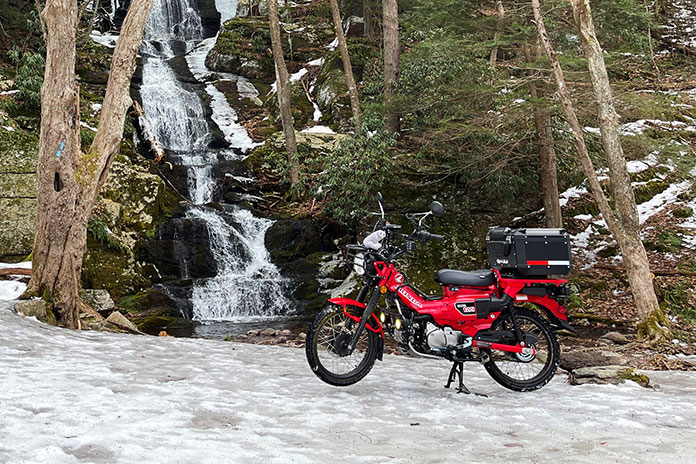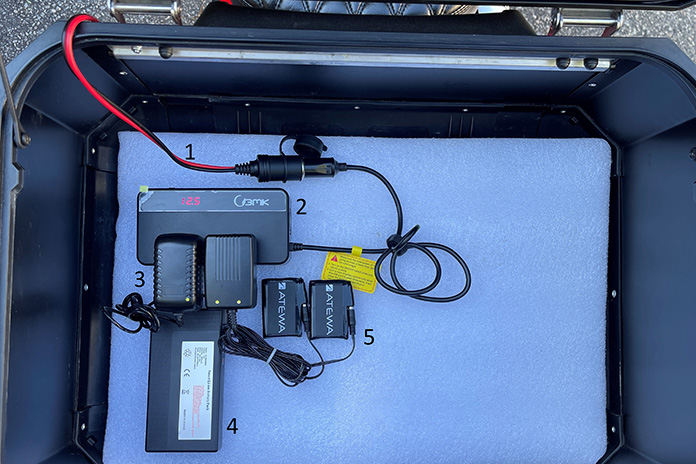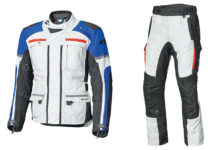If you refuse to be deterred by the weather when it comes to winter motorcycle riding (but are perhaps stymied by the tech – or lack thereof – on your small bike), check out this Exhaust Note feature from “Moto Mouth” Moshe K. Levy that originally appeared in Rider‘s February issue.
Sales of small motorcycles have been booming in the U.S. Their low prices, excellent fuel economy, playful aesthetics, and sheer riding pleasure make minibikes irresistible. My 2021 Honda Trail 125 is so addictive that I find myself hopping aboard its spartan solo saddle not just for local chores but for longer weekend trips as well.
Related: 2021 Honda Trail 125 ABS | First Ride Review
However, all that fun eventually collides against the limitations Mother Nature imposes on those of us who suffer cold winters. Normally, on my big bikes, I just plug in my 12-volt electric jacket liner and gloves and keep on going. But on small bikes like the Trail, there simply isn’t enough electrical capacity to run a full suite of heated gear.
Since parking the bike for the season is never a serious consideration for me, I developed a solution that is relatively low cost, readily available, functionally effective, and applicable for virtually any motorcycle with a marginal electrical output.
First, you need some battery-powered heated gear, which is abundant in today’s marketplace. I’ve had excellent luck with Warm & Safe’s Long Sleeve Heat Layer Shirt, which is powered by a 7.4V, 7.8Ah lithium-ion battery. For gloves, I like Klim’s battery-powered Hardanger HTDs, which operate on 7.4V, 2Ah lithium-polymer batteries. Both products feature multiple heat levels that allow the rider to adjust temperature as necessary, and they have held up well over multiple seasons of abuse.
See all of Rider’s new and reviewed gear here.
Indeed, heated gear is the only thing permitting your faithful, winter-hating Mediterranean columnist to survive arctic riding – at least until the batteries deplete! And therein lies the rub: To stay out all day in the cold, we need continuous power. Here’s how to get it.
First, we need spare batteries for all the heated gear we use. Manufacturers generally offer spares, as does Amazon. Always try to get at least as high an Ah (amp-hour) rating as the original battery – preferably higher. The higher the Ah rating, all else equal, the more run time you will get.
Next, we need to keep these spares continuously charging so they can be swapped in when the original batteries run down. We can accomplish this with a basic square-wave DC-AC inverter and a wiring harness to connect the inverter to the bike’s battery.
My typical setup inside my Trail’s top box is shown in the photo below:
1. Sinloon waterproof cigarette lighter harness, available on Amazon for $9.99, which connects directly to the motorcycle’s battery
2. BMK 200W square-wave DC-AC inverter, available on Amazon for $25.99, which plugs into the Sinloon harness and converts the 12V DC from the bike’s battery to 120V AC
3. AC-DC battery chargers, included with the heated gear and plugged directly into the inverter, which convert the 120V AC output back to 8.4V DC to charge the spares
4. Spare lithium-ion battery for my W&S Heat Layer Shirt
5. Spare lithium-polymer batteries used in my Klim heated gloves
Both the harness and inverter are generic, and it really doesn’t matter which brands you use. (Some riders might already have the wiring harness in place, e.g., for a Battery Tender.)
Everything is secured in my Trail’s top case so things don’t shake around too much. All I need to do is flip the inverter to “on” to continuously charge the spare batteries while riding. Yes, it’s inefficient to convert power from the bike’s 12V DC to 120V AC and then back to heated gear’s 8.4V DC charging voltage, but this setup gets the job done with common, inexpensive components and requires no fancy wiring.
Total draw on this setup is only about 32 watts, including inverter losses. That’s only about one-third of the draw of my 12V DC Warm & Safe jacket liner, so minibikes and even many older bikes with limited electrical capacity should be able to handle this load with ease. Mission accomplished!
Depending on the ambient temperatures and settings of the heated gear, I typically pull over every one to four hours to swap the dead batteries for freshly charged ones, allowing me to stay out all day in the cold – long after most other riders have parked for the season. For a true addict, there is no other choice!
To see a video about this setup, check out the Moto Mouth Moshe YouTube channel.










why not just run heated gear off the bike’s battery?
As Moshe mentions in the second paragraph, “Normally, on my big bikes, I just plug in my 12-volt electric jacket liner and gloves and keep on going. But on small bikes like the Trail, there simply isn’t enough electrical capacity to run a full suite of heated gear.”
I run a Widder vest off the battery on my Monkey and my KYMCO K-Pipe without problems.
The Warm and Safe heated shirt is available in a 12V version that draws a maximum of 48 Watts and is advertised to keep one just as warm as the full jacket liner. I think most conditions do not require full power, I know I usually run my Warm and Safe jacket liner at less than 50% power. Would be very interesting to try using one of the heated shirts on a small, low power bike. Perhaps the author would try that out and let us know?